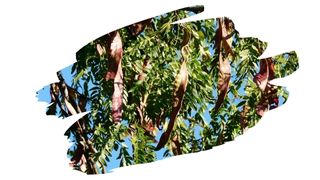A fireplace can be one of the most cost-effective ways to keep your homestead warm. But, it can also be a puzzle picking out a firewood that is both affordable and abundant.
Which is why it’s tempting to want to simply use any free lumber you come across. Especially if that lumber is as widely available as the Honey Locust tree.
Growing right across North America, you’ll be able to find plenty of Honey Locust across eastern parts of the US.
Even so, just because wood is free does not necessarily mean that it also makes for ideal firewood.
So, in this post, you’ll learn what you should be on the look out for in firewood. You’ll also learn why Honey Locust wood (in particular) makes for such great firewood.
And keep reading to find out how much energy Honey locust wood can generate in keeping your home warm.

This post may contain affiliate links to products that we receive a commission for (at no additional cost to you). Learn more here.
What Is The Best Type Of Firewood For An Indoor Fireplace?
If you want firewood to burn safely, then it needs to be dry and free of sap/pitch. Also, firewood needs to be made from wood that hasn’t been harvested from poisonous trees.
Last, but not least, if you want firewood to actually heat your home, it should also be fairly dense too. The more ‘stuff’ there is for fire to burn, the more energy (and thus heat) is produced.
With all of this in mind, is it any wonder that hardwoods such as White Oak and Birch make for great firewood? Especially when they contain little sap, are tough and dense, and they are non-toxic tree species.
Related Post: Is Mimosa Tree Timber A Good Choice For Firewood?
And What About Minimizing Smoke Emissions? What Causes All Of That Smoke?
If you want to keep smoke emissions to a minimum, then you should only use dry firewood. The moisture in green wood is responsible for producing all of that extra thick smoke.
Now, green wood is simply wood that has been freshly logged and cut. And the moisture in freshly cut wood is very high — it has a moisture content of around 100%.
Nonetheless, if you allow wood to dry out for a number of months, this will bring its moisture content right down.
This is why you should always season wood before you burn it in your fireplace. And you can learn more abut seasoning wood by checking out our post: How To Season Wood (7 Tips)
What Is Moisture Content Exactly? Moisture Content measures the percentage amount of water in a piece of wood. This is usually measured using a device called a ‘Moisture Meter’.
And What Kind Of Wood Absolutely Should Not Be Burned In A Fireplace?
Any wood that comes from a poisonous tree, such as the Yew tree, should not make its way into your fireplace.
These trees poisonous compounds can end up in the fumes and/or soot produced by burning these trees. And those poisonous compounds are much too dangerous to have filling the air in your home.
What’s more, you should also avoid burning wood types that are saturated with tree sap and/or tree pitch. Tree resins are sticky gummy substances that can gather in the soot inside a chimney flue. This gummed up soot buildup in turn can create a blockage, which is a key cause of chimney fires.
Related Post: Is Hackberry Tree Wood Good For Firewood?
Good To Know! So Where Does That Place Honey Locust Wood? Is It Safe To Burn?
It absolutely is. This tree is non-toxic, and it doesn’t contain much sap either.
In fact, it’s so non-toxic, that it’s even safe to have Honey Locust around in a house full of pets. Especially since Honey Locust is not toxic to cats or dogs.
Great! And Will It Heat Up My Home?
Well, another tick in the box for Honey Locust firewood is the density of this timber. This is an incredibly dense hard lumber, one that is harder than White Oak and Birch wood.
It’s high density means that it takes a fair amount of energy for fire to burn and consume this timber. And this is reflected in Honey Locust’s BTU rating.
The BTU (British Thermal Unit) rating measures how much energy it takes to consume a cord of wood. The higher the rating, the more energy it takes to burn. And the more energy it takes, the more heat is produce in the process.
Now, White Oak has a BTU rating of 25.7 BTU, while Birch wood has a rating of 23.6 BTU. However, Honey Locust beats out both of them with an even higher rating of 26.7 BTU.
This means that Honey Locust wood can more than take on the job of heating up your homestead — and some. So, as long as you simply make sure that honey locust firewood is well seasoned, it’ll make for ideal firewood.
And How Long Does It Take To Season Honey Locust Wood?
It takes around six to twelve months to season wood, depending on when it was logged.
Basically in hotter warmer months, it takes less time to dry out, than in colder and/or damp seasons. Regardless, if you cut that tree in the height of summer, it should be ready by winter.
To Wrap Up, Here Are The 3 Key Takeaways From This Post…
- 1). Good firewood is dense, contains very little sap, and does not come from toxic trees.
- 2). On all three counts, Honey Locust tree wood hits the mark. So, this hardwood makes for fantastic firewood.
- 3). However, always make sure Honey Locust firewood is dry before you add it to the fire. This will keep smoke emissions to a minimum.
References:
Wood Heating | Forestry.usu.edu
Wood Smoke Awareness | EPA.gov
Honey Locust | ASPCA.org



